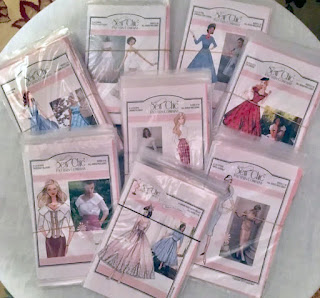Just what is half scale and what is a half scale sewing pattern?
I get this question all the time.
It's not something that everyone works with, and the word "scale" can mean so many different things, so it can cause confusion. Fish, music, and weight measures all have scales, but in this case, scale refers to proportion between two sets of dimensions.
In fashion patterns, a full scale pattern refers to the size of a person, whatever proportions those are. Full scale is a human scale. Half scale is relative to that human, being exactly 1/2 of those proportions. In some cases we may also use a quarter scale, which is 1/4 proportion. In short, half scale: is one half the size and measurement of a full size person. This means what ever shape or proportions the full scale person has, the half scale will have that same shape and proportions, just smaller. With this in mind, let’s talk about products, uses, and reasons to use this scale.
The half scale dress form is of great use to designers, teachers, and students of design. Teachers use this scale when teaching because it saves time and resources, and students are expected to learn very quickly. Students must create the pattern and then make it up to check their work on the form. The teacher grades each student for accuracy of design, proportions, and pattern making.
Designers use half scale to visualize, work out an idea, or design something new. Madelaine Vionnet is a renowned designer of the 1930s who always designed her bias dresses in half scale first.
Instagram is full of elaborate gowns and fantasy outfits made in half scale. Look carefully for signs of scale the next time you spot one of these eye-popping garments.
Sew Chic half scale patterns will fit the "My Size Barbie" that comes in both a 28" and 32" height and has a 25" waist, which would be 30" in full scale. Just like full scale, the half scale patterns are graded to fit more than one size. Measure your doll at the bust, waist, and hip just like you would a full size person to find out what size to cut for your womanly shaped doll.
Here, Barbie is wearing the Palazzo Pant and Portrait Blouse.
- Though half scale is not a good choice for working out fitting details, it can help with practicing specific alterations.
- If you love the idea of making women's clothing in miniature, half scale is the "designer" way to make cute and even elaborate clothing just for the pleasure of the doing and/or display.
- If you are a beginning seamstress and want to "practice" the assembly of a pattern first, it will give you a once through to work out the challenges before making the design in full size.
- Half scale patterns are a great way to experiment with hacks or alterations for design. It avoids wasted fabric and time just to find out the idea wasn't that cute after all!
Did you know that any full scale PDF can be printed at half scale just by setting the printer scale to 50%?
Buy them printed at scale here: https://sewchicpatterns.com/product/half-scale-patterns/
I hope you'll discover new and interesting ways to use half scale in your next level sewing journey!
How do you use half scale and how has it been useful to you? I'd love to read your thoughts on this topic.
Have a great sewing day!
























































